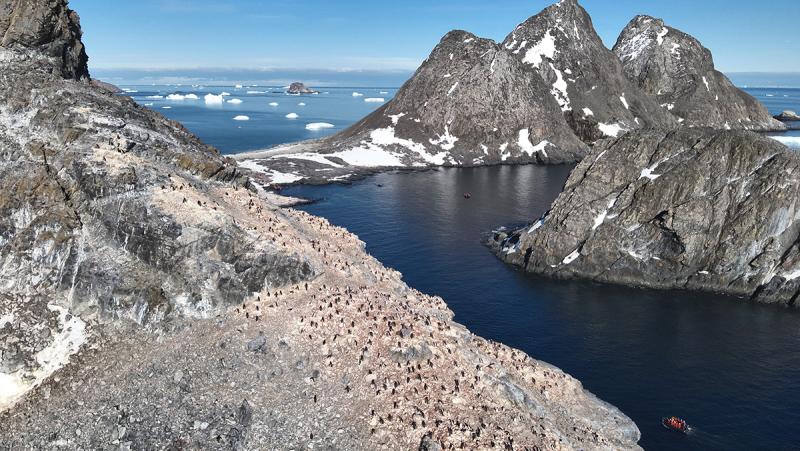Talk about a cool experience: Viking has revealed that its expedition team supported the discovery of a new colony of chinstrap penguins. The discovery was made on Diaz Rock, near Astrolabe Island in Antarctica in January when Viking Octantis visited the three-mile-long island, located in the Bransfield Strait of the Trinity Peninsula.
Astrolabe Island is home to a colony of chinstrap penguins that had not been surveyed since 1987. During the visit, Viking’s scientific partner, Oceanites, a leading field research entity in Antarctic penguin monitoring, conducted a visual and thermal aerial survey. The fieldwork documented the first survey in nearly 40 years of the known chinstrap penguin colony of Astrolabe Island and, in the process, discovered the additional colony on Diaz Rock. Oceanites will share additional details from the survey in a scientific paper to follow in due course.
The findings come one year after Viking published its first scientific paper in Polar Research, the scientific journal of the Norwegian Polar Institute, following its expedition team’s encounters with rare giant phantom jellyfish in Antarctica.
“With our third season in Antarctica underway, we are pleased to have supported another significant scientific development that will allow for further understanding of the region,” said Torstein Hagen, chairman of Viking.
During each Viking expedition, visiting researchers from partner institutions are part of the multidisciplinary 36-person expedition team. This group of experts leads guests through meaningful scientific research, providing guidance and interpretation during shore excursions and delivering world-class lectures.

For 30 years, Oceanites, an American not-for-profit field research entity, has led on Antarctic penguin monitoring. As a scientific partner, Viking supports the fieldwork of Oceanites by mobilizing teams of penguin researchers on its Antarctic expedition voyages and providing thermal cameras. In addition to Oceanites, Viking’s other scientific partners include:
- The University of Cambridge’s Scott Polar Research Institute (SPRI)
- The Cornell Lab of Ornithology
- National Oceanic and Atmospheric Administration (NOAA) Great Lakes Environmental Research Laboratory (GLERL)
- Norwegian Institute of Water Research (NIVA)
- Scripps Institution of Oceanography, UC San Diego
- The IUCN Species Survival Commission Species Monitoring Specialist Group
- Norwegian Polar Institute
Viking offers destination-focused expeditions in Antarctica, the Arctic and North America’s Great Lakes, with an expedition fleet that includes the Polar Class Viking Octantis and Viking Polaris. Designed for discovery by the same team that designed the award-winning Viking Longships and ocean ships, the 378-guest vessels are specifically built for expeditions, at an ideal size for safety, comfort and to support a range of activities in remote destinations.
Related Articles
Antarctica21 Opens Private Club for Fly & Sail Expedition Guests
Scenic Opens Bookings for 2025-26 Antarctica Program
Enticing Expeditions: In-Depth Adventures in Far-Flung Places